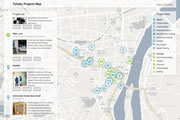RIM: Newsletter of the Pacific Rim Community Design Network
Issue 1 | Issue 2 | Issue 3 | Issue 4 | Issue 5 | Issue 6 | Issue 7, Spring 2014

The 9th Conference. Many thanks to our colleagues in Taiwan for hosting the 9th Conference in March this year. In search for a more immersive experience, the conference this year began with on-site workshops in four different locations in Taiwan, focusing on different themes – Service-Learning Education (Pingzhen), Urban Agriculture and New Ruralism experiment (Pinglin), Wildlife Protection and Environmental Education (Budai), and Placemaking in Displacement (Rinari). Conference participants then joined each other at the Big Table Forum that took place at Chung Yuan University in Chung Li in the last two days. While in Chung Li, we also celebrated Henry Sanoff’s 80th Birthday, the anniversary of Randy Hester and Marcia McNally, and Jim Diers’ resurrection! For information, see our Facebook page and the conference website. (photo: enactment of spoonbill-friendly eco-tourism, aka. the greatest life-action powerpoint presentation)
Sunflower Student Movement. Just as our conference in Chung Li ended, university students in Taiwan took over the Parliament building in Taipei in protest of the passing of the Cross-Strait Service Trade Agreement without a clause-by-clause review. For the next three weeks, the students were joined by thousands more students, activists, and citizens occupying streets around the Legislature forming citizen conferences to discuss issues including future relationship with China and constitutional reform. On March 30, about 500,000 people marched onto the streets of Taipei in support of the student movement. The history-making occupation of the Legislative chamber began on March 18 and ended on April 10 after the Speaker of the Legislature promised to meet the students’ demand. Although the occupation has ended, the broader social and political movement has continued. Learn more about the movement here.


Interactive Mapping Project. Christian Dimmer (Assistant Professor, University of Tokyo) is currently working on two interactive mapping projects: First, an online map that shows community spaces, recovery initiatives and new commons that have sprung up in the aftermath of the Tohoku tsunami in 2011. Second, an online map of Tokyo’s privately owned public spaces (POPS). Both maps serve to empower local communities and to facilitate the emanation of governance and design innovations among members of civil society in and outside of Japan. In addition, he is currently exploring new urban commons and places of empowerment in Tokyo, where people prefigure new modes of living, working, and welfare provision in response to the lingering societal and economic crisis and in anticipation of the transition towards a post-growth society.
To find out about the Tohoku Mapping Project, please visit here.
Personal Notes
Child-Friendly Urban Planning. Kumi Tashiro (TA, The University of Hong Kong) has many experiences of urban and school design workshops with children, in Japan, USA, and Finland, supported by governmental grant. Her research and practice focuses on participatory community activation, child-friendly urban planning, sustainable school design, children’s environment, and design education for children. Her school and community design project in Japan was awarded Good Design Award in 2012, and the Association for Children's Environment Incentive Award in 2013. She is currently a TA of “Housing and Cities” in the Faculty of Architecture, The University of Hong Kong.
Climate-Adaptive Cities. Liao Kuei-Hsien joined the School of Architecture, Chinese University of Hong Kong (CUHK) as Assistant Professor since December 2013. She is also a faculty Urban Studies Programme at CUHK. She continues to focus her research on urban resilience and adaptation, looking at how cities can adapt to increasing flood risks in the era of climate change.
Eco Urban Lab. Perry Yang (Associate Professor, Georgia Institute of Technology) was recently involved in an initiative of Georgia Institute of Technology and Tongji University, as the Co-Director, to build the Sino-U.S. Laboratory for Ecological Urban Design (aka. Eco Urban Lab) in Shanghai and Atlanta. The Lab, launched in January 2014 in Shanghai, focuses on urban energy and eco performance, multi-scale urban modeling and its connection to urban design as a normative approach to designing future urban systems. Cities in U.S. and China will be taken as the city laboratory for urban and climate challenges of the next decades.
Recent Publications
Dimmer, C. 2014 (forthcoming). Evolving Place Governance Innovations and Pluralising Reconstruction Practices in Post-disaster Japan, Planning Theory & Practice 16, Issue 2, forthcoming.
Dimmer, C. (Ed.) 2013. ‘Privately Owned Public Space: The International Perspective’, SUR: Sustainable Urban Regeneration, Volume 25.
Hou, J. 2014. Making and Supporting Community Gardens as Informal Urban Landscapes. In Mukhijia, Vinit and Anastasia Loukaitou-Sideris (eds.), The Informal American City: From Taco Trucks to Day Labor, MA: The MIT Press.
Hou, J. 2014 Life Before/During/Between/After Service-Learning Studios. In Bose, Mallika, et al. (Eds.), Community Matters: Service-Learning in Design and Planning. London: Earthscan.
Hou, J. (ed.). 2013. Transcultural Cities: Border Crossing and Placemaking. London and New York: Routledge.
Liao K-H. 2014. From flood control to flood adaptation: a case study on the Lower Green River Valley and the City of Kent in King County, Washington. Natural Hazards 71: 723-750.
Liao K-H. 2012. A theory on urban resilience to floods—a basis for alternative planning practices. Ecology and Society 17(4): 48. http://dx.doi.org/10.5751/ES-05231-170448.
Mugerauer R, Liao K-H. 2013. Ecological design for dynamic systems: landscape architecture’s conjunction with complexity theory. Journal of Biourbanism (2012) 2: 29-49.
Yang, P. P. J. 2014. Global benchmarking for a low carbon urban system design: A forward-looking modeling approach to Geodesign, in Geodesign: Integrating design and geospatial science in Europe, Scholten H, Lee D and Dias E (eds.), Springer.
Yang, P. P. J., Quan S. J., Castro- Lacouturea, D., Rudolpha, Ben Stuart, B. 2014. Performance metrics for designing an algae-powered eco urban district: A Geodesign perspective, in Energy Procedia, Elsevier.